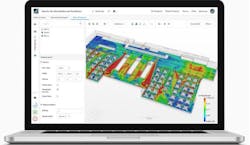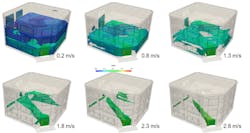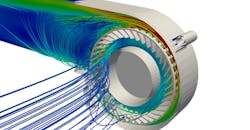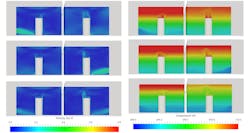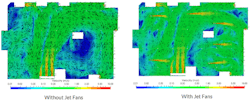Computational fluid dynamics (CFD) is an already established technology. It has allowed scientists and engineers to model and predict flow performance in innumerable fields of application for many decades. And the limits of its application continue to grow as computational power increases. For example, the latest trend of cloud computing has given small companies and consultancies the power to run large and complex simulations with minimal hassle and without the related hardware and software costs.
Ventilation (understood as air moving through an enclosed space) is the main mechanism for HVAC systems to achieve their goal, be it to provide thermal comfort or other special indoor conditions. Traditionally, rules of thumb and approximate hand calculations are used to dimension ventilation equipment capacities and parameters. However, this approach relies on established safety margins and late-stage physical testing and adjustments to guarantee requirements compliance.
- For more from SimScale on CFD simulation, click here.
The typical result of this approach is the specification of oversized equipment and, consequently, an increase in upfront costs and energy consumption. In fact, fans constitute 13% of total energy consumption in the U.S. in the commercial field and 6% in residentials. CFD comes to the rescue in this situation, allowing precise forecasting of the performance of a ventilation system by modeling the physical phenomena, ambient conditions and the detailed geometry of the precinct.
In this article, we will take a look at some common ventilation system design examples and the benefits of tackling the analysis with CFD.
Passive Ventilation
Also known as natural ventilation, this strategy takes advantage of natural phenomena, such as wind flow and buoyancy, to create the pressure differences that drive air changes within the building. For this to happen, special features have to be implemented in the design, such as envelope openings, heat accumulation boxes and exhaust ducts.
CFD is a very powerful tool to predict the behavior of passive ventilation systems because it can precisely model special phenomena, such as buoyancy due to temperature or humidity differences. It can also take into account virtually any geometrical feature, so innovative solutions can be tested and validated before prototyping or construction.
In this example case (Figure 1), the natural ventilation of a three-story shopping mall building is simulated using CFD. Results are extracted to compare against code requirements, and we discover that these are not sufficiently met.
Figure 1: Results of natural ventilation simulation of a three-story building. Source: SimScale blog
Ventilation Equipment
When a passive ventilation strategy is not enough to comply with performance requirements, a forced ventilation strategy is needed. This is achieved through the implementation of fans, blowers or compressors to create pressure differences and drive air changes in the target space.
CFD provides great assistance in the design process of air movement equipment. It allows engineers to predict performance in terms of pressure distributions, flow paths and velocities. Design variations can then be tested and compared in a rapid manner, all in a virtual environment.
In this example study (Figure 2), the aerodynamic performance of a centrifugal fan was investigated with the use of CFD simulation. Performance curves were extracted and areas of improvement were identified.
Figure 2. Flow simulation of a centrifugal fan. Source: SimScale Blog
Displacement Ventilation
In the traditional mixing ventilation strategy, conditioned air inlets are placed at the top of the space and at high flow speeds. In contrast, the displacement ventilation strategy places air inlets near floor level and uses relatively low flow speeds. The hot air produced by occupants or equipment rises to ceiling level through buoyancy (the so-called thermal plumes), where it is consolidated and removed from the space without recirculation. A common application of this strategy is found in classrooms and office spaces because it delivers improved air quality.
In the presented example (Figure 3), CFD simulation is used to compare mixing and displacement ventilation strategies in an office space. Results are presented in terms of temperature distributions and local thermal comfort visualizations, revealing that the displacement ventilation strategy can have the benefit of lower energy consumption and improved air quality.
Figure 3. Velocity and temperature distribution in an office space where different ventilation strategies are used. Source: SimScale Blog
Jet Fans
Jet fans are used to direct and reinforce flow within large spaces. Used in conjunction with the strategic placement of inlets and outlets, optimal flow behaviors can be achieved in difficult conditions.In the studied example (Figure 4), this ventilation strategy is used to drive down contamination levels in a large garage space and eliminate high-concentration zones. Though the use of CFD, the strategy, fan placement and performance are all evaluated in a fast and efficient manner. The results revealed that the proposed strategy would reduce contamination levels by 55.1%.
Figure 4: Flow visualization in a garage and comparison with the use of jet fans. Source: SimScale Blog
Thermal Comfort Code Compliance
An area where CFD simulation is particularly useful is in the assessment of code compliance. CFD allows engineers to measure variables such as temperature and flow speed at any point in the considered geometrical space. This means code performance criteria can be easily extracted and interpreted and improvement areas can be identified. In the presented case studies, through the use of CFD simulation, the thermal comfort performance of a theater space is assessed according to two standard codes:
EPBD and EN 15251
The Energy Performance of Buildings Directive (EPBD) was adopted in 2002 with the objective of improving the energy efficiency of buildings. As part of this directive, the EN-15251 standard was created to specify requirements for indoor thermal comfort.
In this study case (Figure 5), the thermal comfort in the theater is assessed according to EN 15251. The findings reveal that the ventilation system is under performing and improvement areas are identified.
Figure 5. PMV index (predicted mean vote) visualization of a theater, according to EN 15251. Source: SimScale Blog
ASHRAE Standard 55
The American Society of Heating, Refrigerating and Air-Conditioning Engineers (ASHRAE) has published the Standard 55 “Thermal Environment Conditions for Human Occupancy” since 1966. It has also been adopted by international bodies such as ISO and many other countries.
In the study case, ASHRAE 55 metrics are used to compare thermal comfort performance between two ventilation strategies (Figure 6) in the theater, which were simulated with CFD.
Figure 6. Comparison of EDT index (efficient draft temperature) between two ventilation strategies for a theater. Source: SimScale Blog
Conclusion
Today, CFD technology is more accessible than ever. Its power can now be harnessed by a wider range of companies of all sizes and budgets, and products such as the SimScale cloud-based CAE platform make this possible.
In this article, example applications in the HVAC industry were presented and the benefits of CFD simulation to assess performance are evident. These range from design alternatives investigation to results visualization and code compliance criteria calculation, all of which are achieved in a fast, reliable and straightforward manner with CFD technology.
You can try the SimScale cloud-based simulation platform for free here by creating a Community account or starting a 14-day free trial for the Professional plan.
